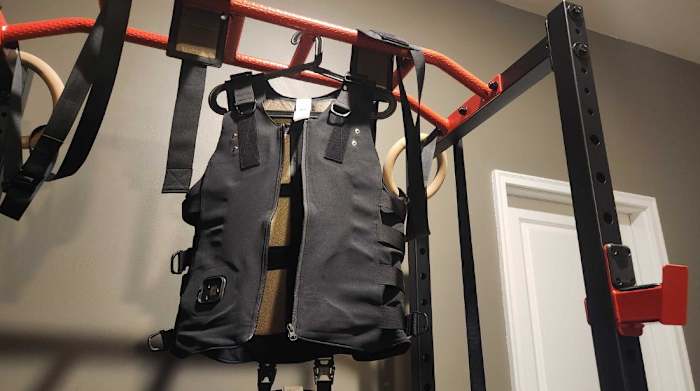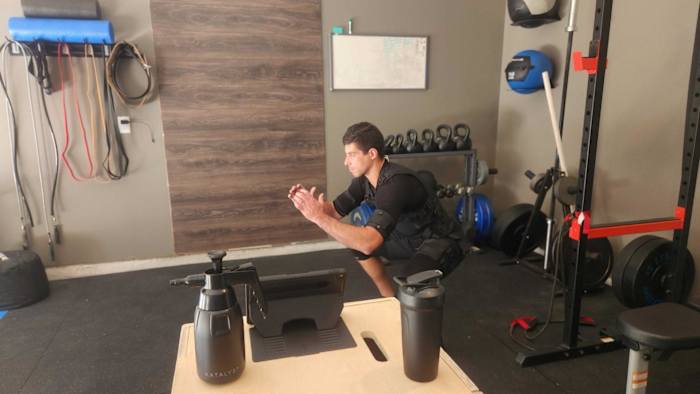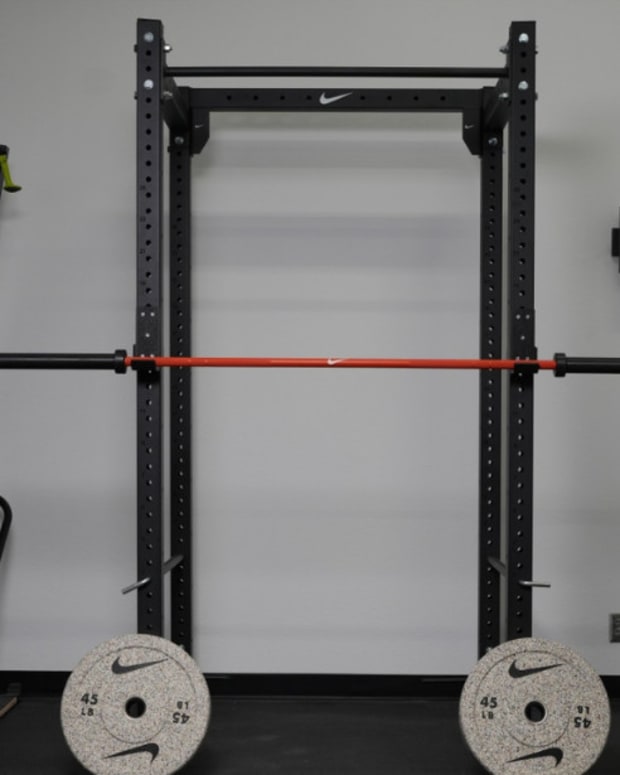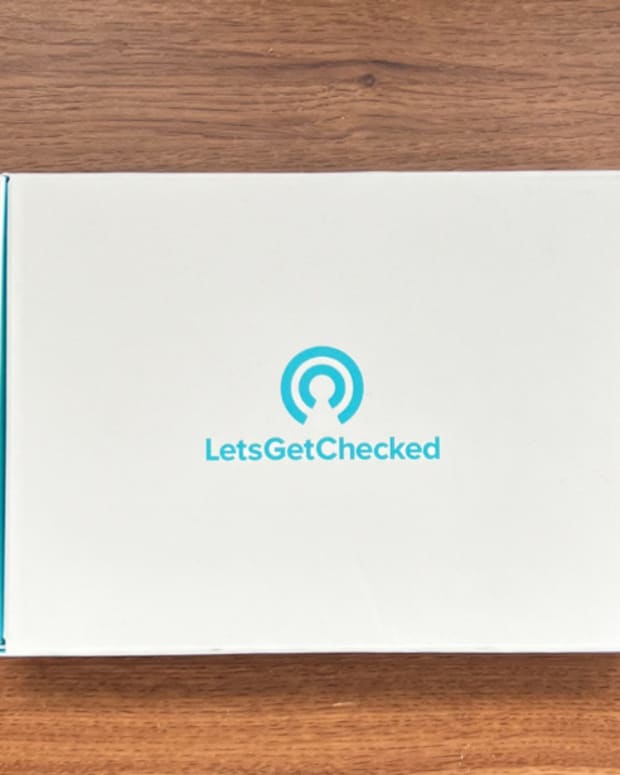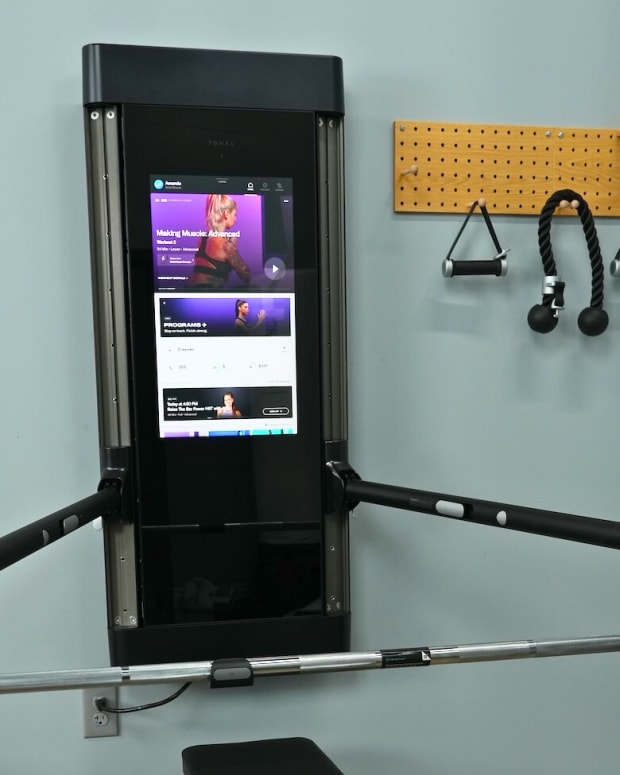The products featured in this article have been independently reviewed. When you buy something through the retail links on this page, we may earn commission at no cost to you, the reader. Sports Illustrated editorial staff are not involved in the creation of this content. Learn more here.
Key Features:
- Electrical muscle stimulation device that activates up to 90 percent of muscle fibers
- Provides an efficient full-body workout in just 20 minutes
- Ability to work out anywhere with no need for additional equipment or weights
- Wide variety of workouts available including strength, cardio, HIIT, mobility and more
As technology continues to be an integral part of our daily lives, it’s no surprise that it’s also transforming the way we approach fitness. From wearables such as the Fitbit, Oura Ring and Whoop 4.0, to smart home gyms like the Tonal, Peloton and Aviron rower, the blending of fitness and tech is more apparent than ever.
This is why I was excited to try the next evolution in workout technology, the Katalyst training system. This whole-body electrical muscle stimulation (EMS) device takes a vastly different approach to helping individuals exercise and strengthen their bodies. Katalyst claims that its hyper-efficient 20 minute workouts are able to deliver superior results to a two-hour-plus long gym session.
We’re here to put that claim to the test and discover whether the science behind EMS technology can truly deliver these electrifying results. We had the opportunity to try out the Katalyst suit for ourselves and will discuss exactly how the device works, the standout features, pros and cons, customer reviews and everything else you need to know about this futuristic training tool.
What Is Katalyst?
Katalyst is a fitness system that’s designed to provide the most efficient workouts possible. While the EMS suit is what delivers the electrical impulses that cause muscle contractions, the actual fitness program is a robust library of five to 20-minute on-demand workouts compiled in the Katalyst app. These workouts are subdivided into five categories including strength, cardio, high-intensity interval training (HIIT), mobility and sport-specific training. Katalyst has also committed to consistently adding new workouts to the platform to prevent any repetitiveness from occurring.
All of the classes are led by certified instructors who will take you through your specified workout routine. Despite the workouts featuring a relatively simple combination of bodyweight movements, they require a significant amount of effort to brace against the electrical impulses. This electro-stim also increases in intensity over the duration of your workout, which adds an additional layer of difficulty to your training session. I like to think of this increase in intensity as being similar to adding more weight to a barbell as you progress through a set during a conventional gym workout routine.
How Katalyst Works
Construction and design
The composition of the Katalyst suit itself is most similar to a snug-fitting neoprene wetsuit. It’s made of a lightweight durable fabric. Maurice Daum, Katalyst’s business development manager, notes that the suit is also combined with hygienic antimicrobial elements to keep it fresh between wears.
In addition to the suit, you are also provided with two sets of machine-washable base layers, which are specially designed to retain moisture in order to deliver optimal conductivity to your muscles. These base layers are constructed from a Tencel fabric blend and are completely seamless to keep you comfortable throughout your workout.
In regards to sizing, after you place your order you will receive an initial email requesting a few body measurements to help Katalyst properly configure your suit. It’s definitely worth taking the time to grab a tape measure rather than estimating your sizes. A snug fit is essential to ensure the electrical impulses are able to effectively target your muscles.
Console and controls
The suit is brought to life via the Katalyst impulse battery pack that sits securely in the right back pocket of the shorts, and lasts around eight workouts per charge. This impulse pack is what sends the electrical currents through the 26 integrated electrode pads which are distributed across the vest, shorts and arm straps. These electrodes have been strategically mapped to all of the major muscle groups of the body, which allows for a completely hands-free, no-weights-necessary full-body workout.
During your first Katalyst session, you will set your desired intensity levels, which range from 0 to 400, for each of the different muscle groups that correlate with the electrode pads in the suit. These muscles include the quads, hamstrings, glutes, abs, lower back, middle back, upper back, chest and arms.
A video demonstration will show you how to do this. It instructs you to slowly increase the intensity of the electrical pulses until you feel a complete muscle contraction on both sides of the body. This is noteworthy because for certain muscle groups, such as my chest, I noticed that my left pectoralis muscle contracted fully at a lower intensity than my right side. This meant that I had to continue to raise the electrical intensity until my right pec fired equally.
My initial thought to explain this phenomenon was that I had small muscular imbalances throughout my body. However, to gain expert insight, we consulted with Nicola A. Maffiuletti, PhD, the head of research at the Schulthess Klinik Human Performance Lab in Zurich, Switzerland. “The side-to-side differences you have observed are only the result of anatomical (normal) differences in motor nerve orientation with respect to the electrodes (the electricity targeting the motor nerve not the muscle fibers directly) and/or asymmetrical electrode positioning with respect to the nerve,” he says. This basically means that the motor nerves that cause my muscles to contract are in slightly different places on the right and left side of my body.
I also noted that the larger muscle groups, such as the quads, hamstrings and glutes were able to handle higher intensities than smaller muscle groups like the abs and arms. While this makes logical sense, I always enjoy understanding the reason why these things occur. It turns out that the larger muscles in the body, which are designed to generate a higher force output, have more total muscle fibers. This means that the motor units of these larger muscles, which allow the actual muscle contraction to take place, are responsible for innervating (controlling) a larger number of muscle fibers. Therefore, in order to activate these individual motor units, a greater electrical intensity is necessary to cause a full muscle contraction.
Once you have completed your initial intensity adjustment, you are then ready to hop into your first workout. Once you press play, the Katalyst app will take control of the suit. At the start of the workout you will perform a quick warm-up of exercises at an intensity level slightly below your initial settings. From there, as the workout progresses, the Katalyst app will continuously up the intensity level to challenge you and help you progress. If you ever feel uncomfortable or that the intensity level is getting too high, then you can pause the workout and lower the electrical impulses back down to a level that’s right for you.
Standout features
The standout feature of the Katalyst is that it’s made for anyone while also being highly personalized. Regardless of your experience level in the gym, anyone can put on the suit, adjust the intensity levels to meet their needs and execute a great workout. The fact that Katalyst also doesn’t involve any weights means that it’s low-impact and joint-friendly, and eliminates any form concerns for beginners who are looking to get started with a new workout routine.
The suit also helps with precise targeting and activation of the muscles, which may lead to faster results and more balanced muscular development. A study published in the Journal of Applied Physiology measured the effects of a six-week EMS training program on 15 sedentary adults. Each of the participants completed an average of 29 EMS sessions, with the device focused on the large muscles of the legs. The results showed significant improvements in peak aerobic capacity, walking distance and quadriceps strength, however, no statistical difference was seen in terms of body mass index (BMI).
These results suggest that EMS can be used to improve physical fitness, but may not necessarily result in weight loss. Muscle tissue is more metabolically active than fat, so it stands to reason that as long as they continued to use the EMS device to build muscle, and they ate a similar diet, eventual weight loss would likely occur.
Working Out With Katalyst
Over the past 15 years I have tried a variety of different exercise routines, ranging from cardio based workouts such as running, biking and swimming, to weight training like Olympic lifting, powerlifting, HIIT classes, circuit training, CrossFit, yoga and more. Despite trying all of these different activities, working out with the Katalyst EMS suit was unlike anything I had ever experienced before.
Unboxing the suit
After unboxing the suit, I took inventory of everything I had laid out in front of me. Purchase of the Katalyst training system included the suit vest, shorts and arm straps, the electrical impulse back with USB charging cable, two sets of base layers, tops and bottoms and most intriguingly a water spray bottle.
Excited for my first workout, I put on my base layers and plugged in my impulse pack to ensure it had a full charge. Note that Katalyst recommends no additional clothing underneath the base layers to allow for maximal contact between the electrode pads and your muscles.
For the next steps, I was instructed to head to YouTube and watch the “Katalyst - Getting Started” guide which is available on the Katalyst YouTube channel. In this video demonstration, Katalyst’s business manager Maurice Daum takes you through the suit preparation and electrode pad priming, putting on the suit, connecting the impulse pack and setting your intensity settings. For new users, this video is definitely worth the watch.
Suit setup
The video instructs users to first grab a large towel and lay it out on a flat surface. Due to the mysterious water spray bottle, I decided it was best to do everything in my garage for the initial test run. So I set up a small card table, laid out the towel and placed the vest, shorts and arm straps on top. I then proceeded to connect the vest and the shorts via two clips and unzip the entire suit, including the arm pads, to expose the electrode padding that laid underneath.
The video then instructed me to go fill up the water bottle with warm water and pump the handle approximately 20 times to add some pressure. It was now time to prime the pads. I placed the spray bottle nozzle into one of the pads and watched the water simply bead off the top, which was incorrect. I realized I needed to press the nozzle firmly into the pad to ensure the water actually entered the padding. Be sure to use a zig zag pattern as you move the spray bottle down the pads to ensure optimal saturation. In the training video, Maurice explains that you have filled the pad correctly when you press down lightly on the pad and see a small pool of water start to appear.
What’s nice is that you really can’t mess this part up, aside from under-filling the pads (the suit will notify you of this—more on this later). Just be aware that the pads can take more water then you might think. By the time I had finished filling the remainder of the 26 pads with water I had made quite a mess. Despite the towel, there was a fair amount of water that had dripped down onto the floor, so definitely consider your first-time setup area carefully. It may also be worth keeping a second towel on-hand for a quick clean up. Note that this process does get easier, and less messy, the more times you use the suit.
Putting the suit on
Now that my suit was primed, it was finally time to put it on. I started by putting on the vest and was happy that they had mentioned using warm water to prime the pads. While you could definitely feel that the suit was wet, you really don’t notice the water once the suit is on. I proceeded to zip up the vest and moved onto the shorts, which are secured by a belt that sits at hip level. Be sure to situate the shorts in such a way that the two electrode pads are placed over the quads and hamstrings respectively.
It was then time to tighten all of the straps. There are two straps on the shorts, four straps down the sides of the vest around the abs and two more at the shoulders. Starting from the bottom up, I pulled on each of the straps until they felt nice and tight. Last but not least, I grabbed the arm straps and looped them loosely in order to slide them up my arms. Note that the pads are interchangeable for either arm; there isn’t a right and a left. Similar to the shorts, ensure that the electrode pads are covering your biceps and triceps respectively and then tighten. You will know they are situated correctly when the strap creates a small gap on the inside of your arm.
The final step involved grabbing the arm connectors and snapping them onto the armbands and the top of the vest, there is one for each side. I then grabbed the impulse pack from the charger, placed it in the rear right pocket of the shorts and connected it magnetically to the shorts and the vest.
Pairing the suit to your iPad or iPhone
Note that in order to use the Katalyst you need an iPad or iPhone capable of running iOS 15 or higher. Unfortunately, there is no app for Android users at this time so you will need to purchase an iPad if you want to use this product.
In order to pair the suit via bluetooth to the iPad, I had to open the Katalyst app on the iPad and start the pairing procedure by holding down the power button on the impulse pack until the blue light switched from slow to quick flashes. I then released the power button, selected a random workout from the app and the iPad requested to pair with the impulse pack. Since this was my first time using the suit, the app brought me to a workout preparation screen in which the suit performed a diagnostic check. This check is to ensure that the pads are fully saturated with water and that there is significant compression between the electrode pads and your muscles. If something is wrong a red pad will appear on the screen in the position where the problem is. If this occurs, start by tightening the straps and then re-checking the pads on the app. If this didn’t solve the issue, then you will need to add more water to the pads labeled in red. This is why you really want to ensure you soak the pads thoroughly during your initial priming of the pads.
Luckily for me, all of the pads were showing white which meant that the suit was ready to go and I was finally ready to hop into my initial intensity adjustment and first workout. All said and done this entire setup process took around 20 minutes, which I equated to the time it would normally have taken me to drive to the gym. As with anything else, the more times I used the suit the smoother everything went.
Intensity adjustment
During the initial intensity adjustment you are brought to a screen labeled with each of the individual muscle groups. I was prompted to start with the muscles in the legs and selected the quads via the touch screen. I then used the plus symbol to up the intensity of the electrical impulses until I felt a full muscle contraction in my quads. For reference, I began feeling the tingling sensation of the electrical impulse around a setting of 60, but had to increase it to around 100 before feeling a consistent muscle contraction taking place. Once I was happy with this setting, I selected the hamstrings and continued to cycle through the muscle groups to complete the intensity adjustment. Remember not to worry about matching the intensities for each of the muscle groups and focus solely on the setting that gives you a consistent muscle contraction.
During this process I noted a few things. The first was that I had to set higher intensities for the larger muscles in my body, such as the ones in my legs. My quads, hamstrings and glutes were all set around 100, while my abs and arms were contracting consistently around an intensity level of 60. The second was that for some muscle groups, one side of my body would contract before the other. For example, when adjusting the intensity for my chest, my left pec began firing at a setting of 75, however I needed to bump up to 80 before my right pec followed suit. It’s important to choose a setting where both sides of your muscles are contracting together.
During the video demonstration, Daum mentions that most users will start somewhere between 60 and 100 for each of the muscle groups; however, the intensity can be increased all the way to 400. So have no fear that the electrical impulses won’t be strong enough to work for you.
First workout
I was finally ready for my first Katalyst session and loaded up a general strength full-body workout with a trainer named Max. The workout started with the “base” position which is used in a majority of the workouts on the platform. The base is similar to the athletic “ready position,” in which your feet are shoulder width apart, your hands are placed together at chest level and you’re in a slight squat. During the first minute of the workout, while in the base position, I felt the electrical impulses slowly ramp up in intensity until they matched my initial settings.
After the first minute, the impulses came in waves of four seconds on and four seconds off. During the four seconds on, Max instructed me to breathe out and brace against the impulses. After another minute spent in base while getting acclimated to the suit, it was time to start adding some movements. Over the next 20 minutes, we performed chest flys, lunges, bicep curls, oblique crunches, boxing, squats and more, all without any weight. Every few minutes the intensity would ramp up, so you will experience higher intensity levels throughout your workout. Just to be clear, these intensity adjustments are automatically programmed into the workout and controlled via the Katalyst app, there's not a physical trainer out there who is specifically controlling your suit for you. If the electrical impulses ever become too high to handle, which did happen during my second workout, you can pause the session and decrease the intensity back to an appropriate level.
Once I completed the initial workout I was pleasantly surprised at how tired I felt. As someone who works out regularly five to six times per week, I wasn’t sure how I would feel after a 20-minute bodyweight workout. I proceeded to take off the suit, grabbed a hanger out of my closet and hung up the suit to dry. I also got out of the base layers and put on some dry clothes. It was at this point that I realized how drained I was from the workout. The closest thing I could relate it to was how I felt getting out of the pool after a two-hour long college swim practice. I was so tired in fact that I had to lay down and take a 30-minute nap. I was still able to work out that evening at my normal CrossFit class, but I did notice that my body was definitely more tired than usual.
What I Thought About Katalyst
The Katalyst really did exceed my expectations. I was shocked at how effective the workouts seem to be, especially after the initial learning curve. After my first workout, I could tell that I had set my legs correctly but definitely could have gone for a higher intensity in my middle and upper back. After making those adjustments, and having some experience with the suit, the workouts have kept getting better and better.
What Customers Say About Katalyst
According to the Katalyst website, consumers have rated the Katalyst training system 4.9 out of 5 stars. Most of the reviews are centered around the time-saving nature of the suit, with consumers happy that they are able to get effective workouts in under 30 minutes. Many of the reviews also focus on the low-impact nature of the workouts that Katalyst provides. This makes the suit an excellent option for anyone with mobility issues or chronic diseases such as arthritis.
What an Expert Says About Katalyst
In order to provide the best overview of this emerging EMS technology, we consulted with Nicola A. Maffiuletti, PhD. Maffiuletti provides valuable insight into the benefits and potential shortcomings of this new tech.
In terms of benefits, Maffiuletti explains that, “EMS—particularly of lower limb muscles—is very effective to preserve muscle mass and function of patients/subjects who are totally or partially immobilized, such as in bedridden conditions due to illness, injury or surgery.” He also notes that EMS is particularly effective when combined with conventional rehabilitation strategies to help enhance recovery, and to restore muscle mass and function.
Regarding the potential shortcomings, Maffiuletti expresses a major concern when it comes to full-body EMS technology. He states that excessive muscle damage is a serious risk when using an improperly controlled device. “For whole-body EMS, the main difficulty is properly dosing the amount of current for different muscles while performing voluntary exercise,” Maffiuletti says. “This poor control typically ends up in underdosing (meaning there is no benefit from EMS) or overdosing, thereby maximizing the risk of muscle damage which has frequently been observed even after one short session of whole-body EMS.” His advice is to progressively increase the current during the first few training sessions, thereby minimizing the risk of serious muscle damage and delayed onset muscle soreness.
Ultimately, Maffiuletti’s main takeaway is that EMS should not be seen as a substitute for but rather as a complement to conventional training modalities. “EMS does not accelerate the muscle hypertrophy process nor maximizes it compared to heavy-load strength training in healthy individuals,” he says.
The Pros of Katalyst
- Once you have familiarized yourself with the suit setup process, Katalyst provides users a full-body workout in under 30 minutes.
- The Katalyst workouts do not require any additional equipment or weights. This makes this a great product to potentially take with you while traveling.
- It’s very low-impact and easy on the joints. This has wide applications for individuals who are recovering from injuries, have chronic inflammatory disease such as arthritis, or for older adults who have potential mobility issues.
- Katalyst is currently the only EMS training system on the market that has been FDA cleared for at-home consumer use.
- The impulse pack has a solid battery life, lasting around eight workouts per charge.
- The base layers are machine-washable and the suit is made with antimicrobial elements to keep it from getting gross.
- Science supports the use of EMS devices to build lean muscle mass. In one randomized controlled study comparing the effects of whole body electro-muscle stimulation versus high-intensity resistance exercise, researchers found that both workout methods were effective in improving body composition and strength. However, there wasn’t a significant difference between the two groups in terms of these improvements.
- Maffiuletti explains that EMS is also a very effective tool for preserving muscle mass and function in individuals who aren't able to exercise normally due to illness, injury or surgery.
The Cons of Katalyst
- The major con of the Katalyst is simply the investment that it takes to purchase the suit. The Katalyst system costs $2,499 plus tax, in addition to the Katalyst membership which ranges from $29 to $49 per month, depending on the membership length purchased.
- In addition to the suit, you will also need an iPad or iPhone that’s capable of running iOS 15 or higher. If you aren’t currently an Apple iPhone user, then you will need to purchase an iPad in order to use the Katalyst app.
- There is a learning curve that comes with the suit and workouts. For the first few workouts, the initial suit setup may take as long as the actual workout, however, this will get easier and less time consuming the more times you use the product.
- Katalyst is not suitable for pregnant women or those that have a pacemaker.
- According to Maffiuletti, a major con of EMS is properly dosing the intensity of the electrical current for the different muscles in the body. Too low of an electrical intensity means no benefit, and too high can increase the risk of serious muscle damage.
Katalyst Warranty and Return Policy
Katalyst offers a 30-day return policy for anyone who purchases its product. A return request must be initiated with Katalyst customer service before returning the product and the customer will be responsible for the return shipping fees.
Regarding the warranty, Katalyst offers a one year limited warranty starting from the date of the original purchase for the actual suit, and a three year limited warranty on the electrical impulse pack.
Katalyst FAQs
Does the Katalyst Workout work?
Yes, after testing out the suit for myself, I can say that Katalyst does provide a solid workout. There are also a handful of scientific papers, including one that compared whole-body EMS versus high intensity resistance exercise, backing the use of EMS devices as a way to improve strength and body composition. That said, Maffiuletti stresses that EMS should not be the sole workout you’re doing. “EMS does not accelerate the muscle hypertrophy process and should not be seen as a substitute, but rather a complement, to conventional training modalities,” he says.
How long does it take to see the results of EMS?
You will likely start seeing results from consistent EMS use, two to three sessions per week, in about four to six weeks.
Can you lose belly fat with EMS?
Yes, it is possible to lose belly fat with EMS. One study looking at the impact of whole-body electro muscle stimulation on postmenopausal women found that over the course of 14 weeks, women who added EMS to their regular exercise routine showed significant reductions in body fat.
What are the side effects of EMS?
In healthy subjects, there is a low risk of side effects when using an EMS device. Maffiuletti does note that overdosing EMS, using too high of a current, can cause serious muscle damage, including a serious condition known as rhabdomyolysis in which damaged muscle tissue releases its proteins and electrolytes into the bloodstream. He mentions that this potential risk can be mitigated by slowly increasing the electrical intensity over your first few sessions, being sure not to start off too high.
What do you wear under an EMS suit?
Every Katalyst purchase comes with two base layers that are designed to be worn under the EMS suit. These base layers are skin tight and specially designed to retain moisture which is necessary for optimal electrical impulse delivery to the muscles.
Final Thoughts
After testing out the Katalyst, I was impressed. Yes, it does come with a hefty price tag, in addition to a monthly membership, but it does deliver on its time-saving promises and ability to improve strength and overall body composition. If you choose to purchase the suit, just be aware that the suit is definitely not doing the work for you. You can’t simply put on the suit, lay down on the couch and build muscle. Similar to a conventional gym workout routine, consistent training with the Katalyst a few times per week is a must to see progress.
Prices are accurate and items in stock as of publish time.
